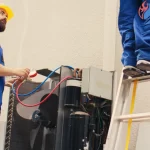Equipment Used to Repair Air Conditioner at Home
When the scorching summer heat arrives, a well-functioning air conditioner becomes an essential appliance in many households. However, like all mechanical systems, air conditioners can experience issues that may require repair. While some AC problems may necessitate professional assistance, there are several tasks you can perform at home with the right equipment. In this comprehensive guide, we will explore the various tools and equipment used to repair an air conditioner at home, helping you stay cool and comfortable during the hottest months.
Introduction to DIY Air Conditioner Repair
Before diving into the equipment needed for DIY AC repair, it’s essential to understand the scope of tasks that can be safely performed by homeowners. Routine maintenance and minor troubleshooting are well within the capabilities of most DIY enthusiasts. However, complex issues, refrigerant handling, and electrical work should be left to trained professionals to avoid potential safety hazards and voiding warranties.
Safety First
Before tackling any DIY AC repair project, prioritize safety. Ensure you have the following safety equipment on hand:
1. Safety Glasses
Safety glasses protect your eyes from debris, refrigerant, and other potential hazards during the repair process.
2. Gloves
Wearing gloves is essential to protect your hands from sharp edges and hot surfaces.
3. Dust Mask
A dust mask or respirator helps prevent inhalation of airborne particles and contaminants from the AC unit.
4. Voltage Tester
A voltage tester allows you to check for the presence of electrical current before handling any electrical components.
Essential Tools for DIY AC Repair
Now let’s delve into the essential tools you’ll need for various DIY air conditioner repair tasks:
1. Screwdrivers
Screwdrivers, both Phillips and flathead, are versatile tools used to remove panels, access components, and tighten or loosen screws.
2. Pliers
Needle-nose pliers are useful for bending, shaping, and holding wires and components in tight spaces.
3. Wire Stripper/Cutter
This tool is necessary for cutting and stripping electrical wires, a common task in AC repairs.
4. Nut Drive
A nut driver helps in tightening or loosening hexagonal nuts and bolts often found in AC systems.
5. Wrench Set
Having a set of wrenches is crucial for various tasks, such as securing refrigerant lines and fasteners.
6. Pipe Cutter
If you need to cut or trim copper or aluminum refrigerant lines, a pipe cutter is essential.
7. Thermometer
A digital or infrared thermometer is useful for checking air temperatures and ensuring proper cooling.
8. HVAC Multimeter
An HVAC-specific multimeter allows you to measure voltage, current, resistance, and temperature, crucial for diagnosing electrical and sensor issues.
9. Fin Comb
A fin comb helps straighten bent or damaged condenser and evaporator fins, improving airflow and efficiency.
10. Condenser Coil Brush
To maintain your AC’s efficiency, a coil brush can be used to clean the condenser coils from dirt and debris.
11. Refrigerant Gauges
Refrigerant gauges are necessary if you plan to perform tasks related to refrigerant levels, such as recharging the system.
12. Vacuum Pump and Manifold Gauge Set
These tools are used for evacuating and charging the refrigerant system, a task best left to professionals due to the need for proper refrigerant handling.
13. AC Leak Detector
An electronic leak detector can help locate refrigerant leaks in your AC system.
14. Pipe Insulation
If you need to replace or repair refrigerant lines, pipe insulation ensures proper insulation and prevents condensation.
15. Duct Tape and HVAC Tape
These tapes are used for sealing leaks in ductwork and insulating connections.
16. Finishing Supplies
Various finishing supplies like epoxy, sealants, and lubricants can be handy for sealing leaks, securing connections, and reducing friction.
Common DIY AC Repairs and Equipment Required
Now, let’s look at some common air conditioner issues that you can potentially address with the aforementioned tools and equipment:
1. Cleaning or Replacing Air Filters
Tools Needed: Screwdriver, vacuum cleaner, replacement air filters
One of the simplest yet most effective maintenance tasks is regularly cleaning or replacing your AC’s air filters. This ensures proper airflow and cooling efficiency.
2. Cleaning Condenser and Evaporator Coils
Tools Needed: Coil brush, fin comb, vacuum cleaner
Dirty coils can lead to reduced cooling capacity. Cleaning them with a coil brush and fin comb helps maintain optimal performance.
3. Checking and Tightening Electrical Connections
Tools Needed: Screwdriver, pliers, voltage tester
Loose or corroded electrical connections can cause AC malfunction. Use a voltage tester to ensure power is off before tightening connections.
4. Replacing Capacitors
Tools Needed: Screwdriver, pliers
Faulty capacitors can prevent the AC unit from starting. You can replace them with the appropriate tools and a new capacitor.
5. Inspecting and Cleaning Condensate Drain
Tools Needed: Screwdriver, pipe cleaner, wet/dry vacuum
A clogged condensate drain can lead to water leakage. Regular inspection and cleaning prevent this issue.
6. Straightening Bent Fins
Tools Needed: Fin comb
Bent condenser and evaporator fins reduce airflow. Use a fin comb to straighten them.
7. Replacing the Thermostat
Tools Needed: Screwdriver, wire stripper/cutter
Upgrading or replacing a faulty thermostat is a DIY-friendly project with the right tools.
8. Sealing Duct Leaks
Tools Needed: HVAC tape, duct tape
Leaky ducts can result in inefficient cooling. Use tape to seal leaks and improve system efficiency.
9. Adding Refrigerant (Recharging the System)
Tools Needed: Refrigerant gauges (best left to professionals)
Refrigerant should only be handled by certified technicians due to environmental regulations and safety concerns.
FAQs
What equipment do I need to repair my air conditioner at home?
The specific equipment you need may vary depending on the type of repair, but commonly used tools include a multimeter, refrigerant gauges, screwdrivers, pliers, a wrench set, a vacuum pump, and a brazing kit.
Can I use common household tools for AC repairs, or do I need specialized equipment?
While some basic household tools can be handy for simple tasks, such as cleaning or changing filters, more complex repairs often require specialized HVAC tools and equipment.
Is it safe for a homeowner to handle refrigerant-related equipment during AC repairs?
Handling refrigerants can be dangerous and should only be done by trained professionals with the proper certifications. Homeowners are generally advised not to handle refrigerant-related equipment.
Can I rent AC repair equipment if I want to DIY a repair?
Some specialized HVAC equipment may be available for rent, but it’s important to have the necessary knowledge and skills to use them safely and effectively. Renting equipment may not be suitable for inexperienced individuals.
Do I need a vacuum pump for AC repairs at home?
A vacuum pump is essential for tasks like evacuating the refrigerant system and removing moisture, which is crucial for proper AC repairs. It is recommended for more advanced repairs and should be used by trained technicians.
Best AC Services Company in Sharjah
Maintaining your air conditioner is essential to ensure its longevity and efficient performance, especially during scorching summer months. Armed with the right tools and equipment, many DIY enthusiasts can tackle common AC issues. However, safety should always be paramount, and for more complex repairs or tasks related to refrigerant handling or electrical work, it’s wise to seek professional assistance. At “Al Hadi AC Repair & Maintenance Services,” we understand the importance of a well-functioning AC system. Our team of skilled technicians is ready to provide expert repair and maintenance services to keep your home cool and comfortable. Whether it’s routine maintenance, troubleshooting, or major repairs, you can count on us to ensure your AC system operates at its best. Stay cool and relaxed all year round with the support of “Al Hadi AC Repair & Maintenance Services.”




